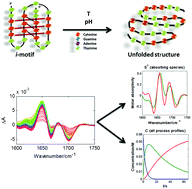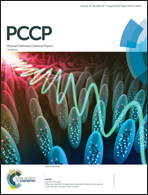Study of light-induced formation of photodimers in the i-motif nucleic acid structure by rapid-scan FTIR difference spectroscopy and hybrid hard- and soft-modelling†
Abstract
The i-motif is a DNA structure formed by cytosine-rich sequences, very relevant from a biochemical point of view and potentially useful in nanotechnology as pH-sensitive nanodevices or nanomotors. To provide a different view on the structural changes and dynamics of direct excitation processes involving i-motif structures, the use of rapid-scan FTIR spectroscopy is proposed. Hybrid hard- and soft-modelling based on the Multivariate Curve Resolution by Alternating Least Squares (MCR-ALS) algorithm has been used for the resolution of rapid-scan FTIR spectra and the interpretation of the photochemically induced time-dependent conformational changes of i-motif structures. The hybrid hard- and soft-modelling version of MCR-ALS (HS-MCR), which allows the introduction of kinetic models to describe process behavior, provides also rate constants associated with the transitions modeled. The results show that UV irradiation does not produce degradation of the studied sequences but induces the formation of photodimers. The presence of these affect much more the stability of i-motif structures formed by short sequences than that of those formed by longer sequences containing additional structural stabilizing elements, such as hairpins.



 Please wait while we load your content...
Please wait while we load your content...